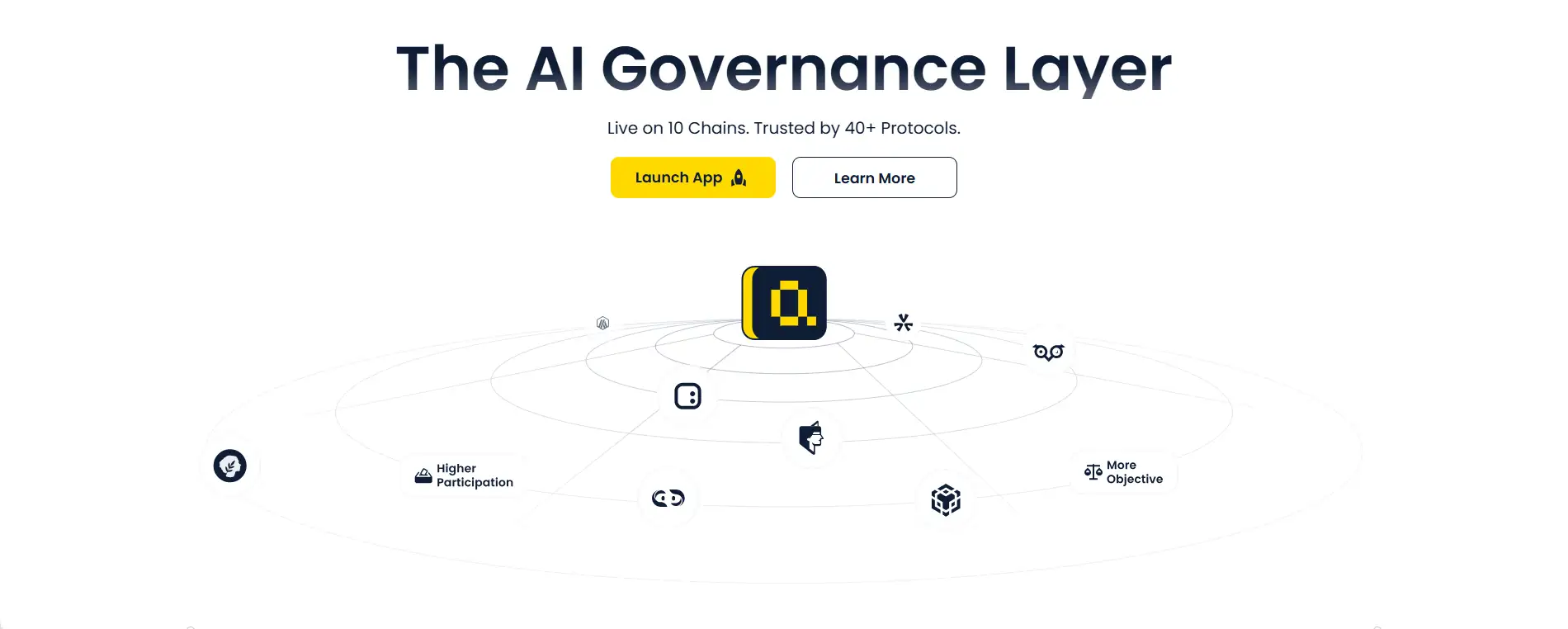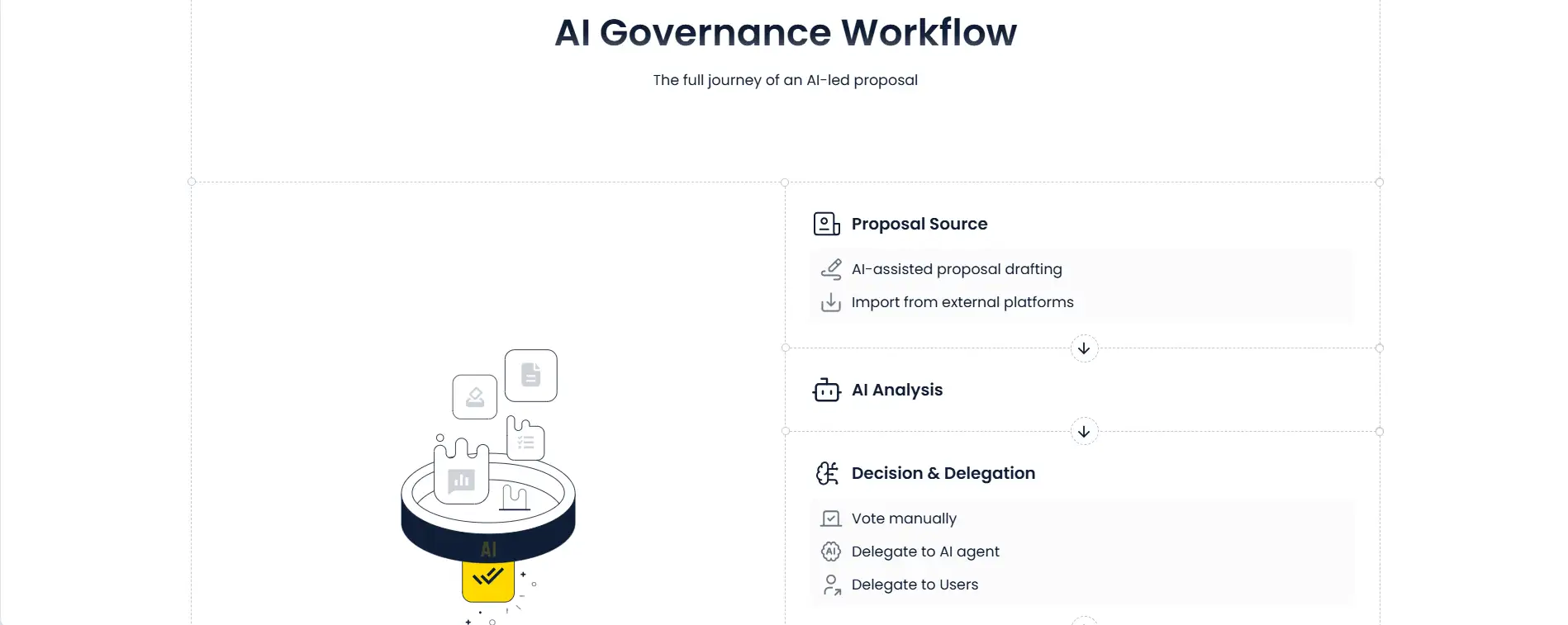About Quack AI
Quack AI is a modular, cross-chain AI governance layer purpose-built for the next generation of decentralized ecosystems and tokenized real-world assets (RWAs). Unlike traditional governance platforms that rely on fragmented polling or manual approvals, Quack AI introduces infrastructure-grade automation to decision-making processes across Web3 protocols and regulated institutions. It brings together AI-native intelligence, programmable execution, and embedded compliance into a unified platform.
Operating across 10+ chains and trusted by over 40 protocols, Quack AI is live infrastructure — not just a toolkit. It offers AI-driven proposal drafting, KYC/AML-ready compliance layers, and verifiable agent-based decision making. This ecosystem empowers both DAOs and real-world financial institutions to implement governance that is fair, fast, and regulation-compliant — all without losing human oversight. Quack AI is building the missing link between intelligent governance and tokenized economies.
Quack AI is not a typical DAO governance tool — it is a full-stack, AI-native governance infrastructure designed to scale with the evolving needs of Web3 and traditional finance. As tokenization expands from native crypto assets to regulated products like tokenized stocks, bonds, and real estate, governance systems must evolve. Quack AI is positioned to meet that demand with an architecture that automates, accelerates, and secures decision-making across chains and jurisdictions.
The protocol introduces a modular governance workflow that spans from proposal drafting to execution and post-vote feedback. AI-powered agents analyze inputs — such as emails, forums, or forms — and generate structured, on-chain proposals. These proposals are categorized, risk-scored, and ranked in real time. Governance agents then either vote based on pre-set logic or can be delegated by users. For human involvement, users can vote directly or select an agent that mirrors their values, ensuring the process stays human-aligned but frictionless.
One of Quack AI’s most powerful differentiators is its embedded compliance infrastructure. With built-in KYC, AML, and audit trails, the system can operate in fully regulated environments — a must-have for real-world asset platforms. Additionally, its Execution Router allows for cross-chain governance actions using quorum-based logic and policy enforcement, replacing the outdated forum/spreadsheet combo still common in Web3.
As of now, Quack AI is live on multiple major blockchains including BNB Chain, Polygon, Linea, Avalanche, Monad, and Metis, with adoption across more than 40 protocols. Unlike typical DAO tools such as Snapshot, Aragon, or Syndicate, Quack AI is built for regulated and tokenized environments — including institutions launching tokenized equities and DeFi protocols coordinating without forums or off-chain processes.
The platform’s long-term roadmap outlines its shift from a product to full infrastructure by 2025, with milestones focusing on community participation, scaling intelligent agents, and mainstream adoption. Through this roadmap, Quack AI aims to redefine governance as a foundational layer, not an operational afterthought — bridging the gap between decentralized innovation and institutional trust.
Quack AI provides numerous benefits and features that make it a transformative force in Web3 governance infrastructure:
- AI-Powered Proposal Engine: Automatically converts raw data sources like emails and forms into structured, ranked proposals ready for on-chain voting.
- Programmable Governance Agents: Users can create AI agents that vote according to personal or institutional values, enabling efficient and customizable governance.
- Built-in Compliance Modules: Native support for KYC, AML, risk scoring, and audit trails — ideal for real-world asset governance.
- Cross-Chain Execution Router: Execute governance outcomes across chains using quorum logic and time-based enforcement, without relying on manual coordination.
- Human-Aligned Automation: Agents don’t replace user intent — they enhance it. Users set preferences and thresholds, while agents execute reliably in real time.
- Full Infrastructure Stack: Unlike DAO tools, Quack AI offers a modular backend stack built for regulated environments and high-value asset classes.
- Live Adoption: Already deployed on 10+ chains and integrated with 40+ protocols, Quack AI is more than a concept — it's a production-grade governance layer.
Quack AI makes it easy to begin automating and upgrading your governance systems through AI-native infrastructure. Here’s how to get started:
- Launch the App: Go to quackai.ai and click “Launch App” in the top menu to access the governance platform.
- Connect Your Wallet: Use a supported wallet (like MetaMask) on any of the integrated chains (Polygon, BNB, Avalanche, etc.).
- Choose Governance Role: Decide whether to participate as an individual user, project admin, or institutional stakeholder.
- Delegate or Create an AI Agent: Select an AI governance agent that aligns with your values, or create a new programmable agent to handle decisions on your behalf.
- Import or Create Proposals: Use the proposal engine to draft proposals from external sources like forums, documents, or emails, and publish them on-chain.
- Execute and Monitor: Proposals are voted on and executed with real-time feedback loops. Monitor results, change settings, or override agent behavior if needed.
- Explore the Docs: Access the full documentation at quackai.ai/docs for advanced configuration, integration options, and governance best practices.
Quack AI FAQ
Quack AI uses programmable AI governance agents that can be customized to reflect user-defined preferences, values, or risk tolerances. These agents have transparent, verifiable decision histories and operate based on logic defined by the delegator. Unlike centralized systems, these agents do not impose decisions — they execute on-chain logic based on criteria set by users or institutions. This ensures that governance decisions are not only personalized but also decentralized and fully auditable via the Quack AI infrastructure.
The proposal engine in Quack AI transforms unstructured content like forum posts, disclosures, and emails into on-chain proposals in real time. These proposals are then categorized, scored, and ranked by AI, eliminating the bottlenecks of manual review and formatting. This feature is crucial for large-scale DAOs that struggle to scale coordination. It helps standardize and accelerate decision-making while maintaining transparency. Quack AI automates what traditionally required hours of labor — enabling DAOs to evolve into intelligent, self-governing systems.
Quack AI features an Execution Router — a native infrastructure component that supports cross-chain governance actions using policy-based enforcement and quorum logic. This eliminates the need for third-party bridges or centralized relayers, increasing both security and reliability. Whether executing treasury transfers or updating protocol parameters across chains, decisions are enforced in a trustless and time-sensitive manner. Quack AI empowers decentralized protocols to scale coordination across multiple ecosystems without fragmentation.
Quack AI integrates RWA governance modules that support regulatory needs such as KYC, AML, audit trails, and proposal-level risk scoring. These features are essential for platforms managing tokenized stocks, funds, and real estate. Real-time tracking of Net Asset Value (NAV), redemption queues, and shareholder rights is built into the system, making it uniquely suited for regulated RWA platforms. By embedding compliance directly into its infrastructure, Quack AI offers institutions a path to operate confidently on-chain without sacrificing legal safeguards.
Quack AI follows a core principle: automation should support, not override, human intent. Users or institutions configure governance thresholds, value preferences, and risk rules, while agents automate voting or decision execution accordingly. Manual overrides are always possible, ensuring that no critical vote happens without optional human input. This blend of AI coordination with user-defined logic offers both scalability and accountability, making Quack AI a uniquely human-aligned governance infrastructure.
You Might Also Like












